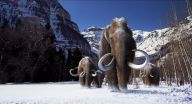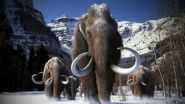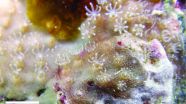(Press-News.org) The first comprehensive analysis of the woolly mammoth genome reveals extensive genetic changes that allowed mammoths to adapt to life in the arctic. Mammoth genes that differed from their counterparts in elephants played roles in skin and hair development, fat metabolism, insulin signaling and numerous other traits. Genes linked to physical traits such as skull shape, small ears and short tails were also identified. As a test of function, a mammoth gene involved in temperature sensation was resurrected in the laboratory and its protein product characterized.
The study, published in Cell Reports on July 2, sheds light on the evolutionary biology of these extinct giants.
"This is by far the most comprehensive study to look at the genetic changes that make a woolly mammoth a woolly mammoth," said study author Vincent Lynch, PhD, assistant professor of human genetics at the University of Chicago. "They are an excellent model to understand how morphological evolution works, because mammoths are so closely related to living elephants, which have none of the traits they had."
Woolly mammoths last roamed the frigid tundra steppes of northern Asia, Europe and North America roughly 10,000 years ago. Well-studied due to the abundance of skeletons, frozen carcasses and depictions in prehistoric art, woolly mammoths possessed long, coarse fur, a thick layer of subcutaneous fat, small ears and tails and a brown-fat deposit behind the neck which may have functioned similar to a camel hump.
Previous efforts to sequence preserved mammoth DNA were error-prone or yielded insights into only a limited number of genes.
To thoroughly characterize mammoth-specific genes and their functions, Lynch and his colleagues deep sequenced the genomes of two woolly mammoths and three Asian elephants - the closest living relative of the mammoth. They then compared these genomes against each other and against the genome of African elephants, a slightly more distant evolutionary cousin to both mammoths and Asian elephants.
The team identified roughly 1.4 million genetic variants unique to woolly mammoths. These caused changes to the proteins produced by around 1,600 genes, including 26 that lost function and one that was duplicated. To infer the functional effects of these differences, they ran multiple computational analyses, including comparisons to massive databases of known gene functions and of mice in which genes are artificially deactivated.
Genes with mammoth-specific changes were most strongly linked to fat metabolism (including brown fat regulation), insulin signaling, skin and hair development (including genes associated with lighter hair color), temperature sensation and circadian clock biology - all of which would have been important for adapting to the extreme cold and dramatic seasonal variations in day length in the Arctic. The team also identified genes associated with the mammoth body plan, such as skull shape, small ears and short tails.
Of particular interest was the group of genes responsible for temperature sensation, which also play roles in hair growth and fat storage. The team used ancestral sequence reconstruction techniques to "resurrect" the mammoth version of one of these genes, TRPV3. When transplanted into human cells in the laboratory, the mammoth TRPV3 gene produced a protein that is less responsive to heat than an ancestral elephant version of the gene. This result is supported by observations in mice that have TRPV3 artificially silenced. These mice prefer colder environments than normal mice and have wavier hair.
Although the functions of these genes match well with the environment in which woolly mammoths were known to live, Lynch warns that it is not direct proof of their effects in live mammoths. The regulation of gene expression, for example, is extremely difficult to study through the genome alone.
"We can't know with absolute certainty the effects of these genes unless someone resurrects a complete woolly mammoth, but we can try to infer by doing experiments in the laboratory," he said. Lynch and his colleagues are now identifying candidates for other mammoth genes to functionally test as well as planning experiments to express mammoth proteins in elephant cells.
While his efforts are targeted toward understanding the molecular basis of evolution, Lynch acknowledges that the high-quality sequencing and analysis of woolly mammoth genomes can serve as a functional blueprint for efforts to "de-extinct" the mammoth.
"Eventually we'll be technically able to do it. But the question is: if you're technically able to do something, should you do it?" he said. "I personally think no. Mammoths are extinct and the environment in which they lived has changed. There are many animals on the edge of extinction that we should be helping instead."
INFORMATION:
The study, "Elephantid genomes reveal the molecular bases of Woolly Mammoth adaptations to the arctic," was supported by the National Science Foundation. Additional authors include Webb Miller (project co-leader), Oscar Bedoya-Reina, Aakrosh Ratan, Daniella I. Drautz-Moses and George Perry from Penn State University, Stephan Schuster (project co-leader) from Penn State and the Singapore Centre on Environmental Life Sciences Engineering and Michael Sulak from the University of Chicago.
MAYWOOD, Ill. - New devices called stent retrievers are enabling physicians to benefit selected patients who suffer strokes caused by blood clots. The devices effectively stop strokes in their tracks.
For the first time, new guidelines from the American Heart Association/American Stroke Association recommend the treatment for carefully selected patients who are undergoing acute ischemic strokes and who meet certain other conditions.
Loyola University Medical Center stroke specialist Jose Biller, MD, is a member of the expert panel that wrote the guidelines, published ...
Infrared date from NASA's Aqua satellite spotted the strongest storms within newborn Tropical Depression 10W over the Philippine Sea today, July 2. It is expected to strength to a tropical storm, at which time it will be renamed "Linfa."
A tropical cyclone is made up of hundreds of thunderstorms, and the highest storms are the coldest and most powerful. To identify those areas with the strongest storms, infrared data is used because it tells temperature. The higher the cloud top, the stronger the uplift in a storm and the colder the cloud top temperature will be.
The ...
By growing two types of stem cells in a "3-D culture" and measuring their ability to produce retinal cells, a team lead by St. Jude Children's Research Hospital researchers has found one cell type to be better at producing retinal cells.
The research not only reveals which stem cell type might be better for treating retinal degeneration, but it also demonstrates a standardized method for quantifying the effectiveness of different stem cells for such therapies.
The research was led by Michael Dyer, Ph.D., a member of the St. Jude Department of Developmental Neurobiology ...
Astronauts on the International Space Station (ISS) have a number of exercise options, including a mechanical bicycle bolted to the floor, a weightlifting machine strapped to the wall, and a strap-down treadmill. They spend a significant portion of each day working out to ward off the long-term effects of weightlessness, but many still suffer bone loss, muscle atrophy, and issues with balance and their cardiovascular systems.
To counteract such debilitating effects, research groups around the world are investigating artificial gravity -- the notion that astronauts, ...
The latest Supplement to the American Ornithologists' Union Check-list of North American Birds was published this week in The Auk: Ornithological Advances, and includes several major updates to the organization of the continent's bird species. More than just a list, the Check-list groups birds into genera, families, and orders based on their evolutionary relationships, and some of the most significant changes in this year's Supplement involve the tanagers, family Thraupidae. "Recent genetic studies have overturned much of what we thought we knew about what constitutes a ...
July 2, 2015 - While heart disease is the number one cause of death in both sexes, it poses special considerations in women--with risks often beginning in childhood and changing at different stages of life. Insights on cardiovascular disease (CVD) risk in women and girls throughout the life span are shared in a special symposium feature in the June issue of The American Journal of Medical Sciences (AJMS). The official journal of the Southern Society for Clinical Investigation (SSCI), AJMS is published by Wolters Kluwer.
Two symposium papers seek to increase understanding ...
ATLANTA - July 2, 2015-Cancer survivors who smoke report fewer negative opinions about smoking, have more barriers to quitting, and are around other smokers more often than survivors who had quit before or after their diagnosis, according to a new study appearing in Psycho-Oncology. The authors say these factors point to potential targets to help cancer survivors quit.
Quitting smoking is important for cancer prognosis, but some cancer survivors continue to smoke. Although initial quit rates are high among those diagnosed with cancers strongly linked with smoking (e.g., ...
A group of scientists led by Dr Kara Hoover of the University of Alaska Fairbanks and including Professor Matthew Cobb of The University of Manchester, has studied how our sense of smell has evolved, and has even reconstructed how a long-extinct human relative would have been able to smell.
The sense of smell plays a decisive role in human societies, as it is linked to our taste for food, as well as our identification of pleasant and unpleasant substances.
We have about 4 million smell cells in our noses, divided into about 400 different types. There is tremendous ...
CORVALLIS, Ore. - Engineers at Oregon State University have invented a way to fabricate silver, a highly conductive metal, for printed electronics that are produced at room temperature.
There may be broad applications in microelectronics, sensors, energy devices, low emissivity coatings and even transparent displays.
A patent has been applied for on the technology, which is now available for further commercial development. The findings were reported in Journal of Materials Chemistry C.
Silver has long been considered for the advantages it offers in electronic devices. ...
Research conducted in Okinawa, Japan, by graduate student Yu Miyazaki and associate professor James Davis Reimer from the University of the Ryukyus has found a very unusual new species of octocoral from a shallow coral reef in Okinawa, Japan. The new species can be considered a "living fossil", and is related in many ways to the unusual blue coral. The study was published in the open access journal ZooKeys.
Unlike scleractinians, most octocorals lack a hard skeleton, and therefore many have the common name "soft coral". One exception is the endangered genus Heliopora, ...



